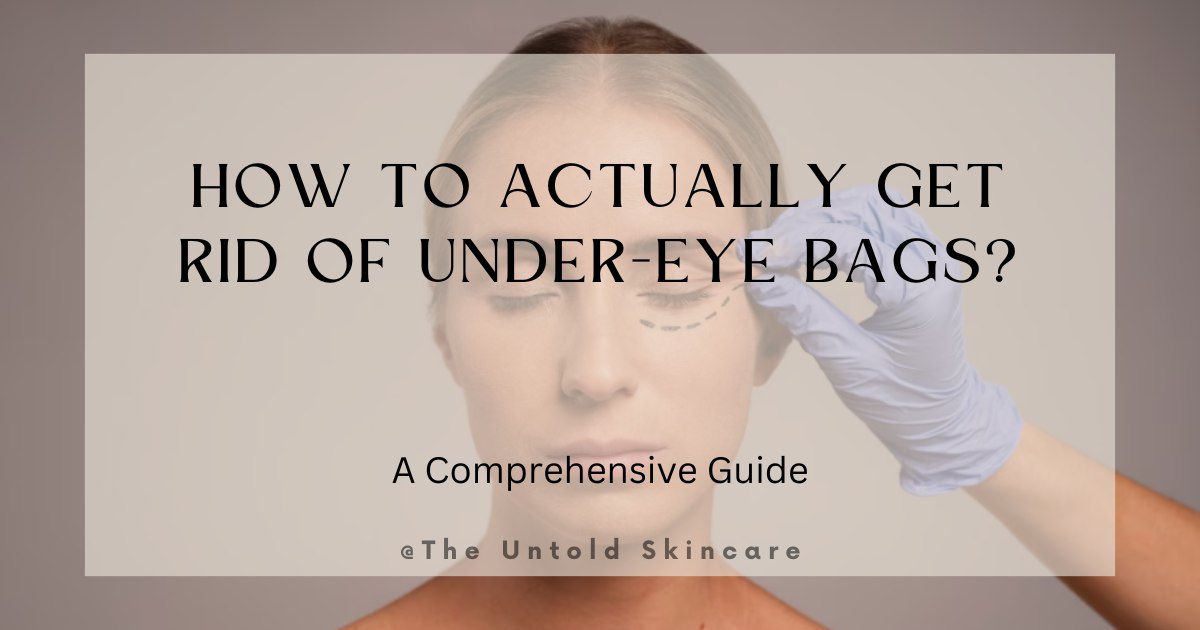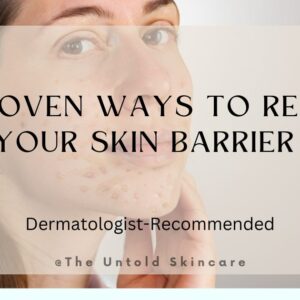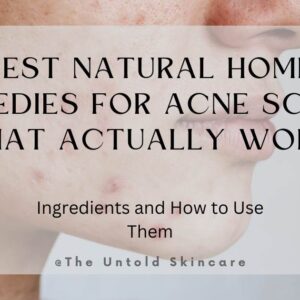Are you waking up every morning and wondering, “Why do I have bags under my eyes, and how can I finally get rid of them?”
You’re not alone. Studies show that up to 92% of people are bothered by some degree of under-eye bags, with both men and women seeking effective under-eye bags treatment every year.
In fact, the global market for eye creams and procedures to address bags under the eyes is projected to reach billions, yet most people still struggle to find the best treatment for bags under the eyes that actually works.
Here’s a bold truth: most “miracle” products for under-eye puffiness treatment are little more than marketing hype.
The real solutions for puffiness below the eyes, below-eye swelling, and stubborn eye bags lie in understanding the root causes and using proven, science-backed strategies.
This post will break down everything you need to know about bags under eyes, including causes, remedies, and the latest treatments you can use to finally get rid of bags under eyes for good.
What are Under-Eye Bags?
Bags under the eyes are characterized by mild swelling, puffiness, or sagging of the skin beneath the lower eyelids.
While often harmless, they can make you look tired, older, or unhealthy, affecting self-confidence and first impressions.
The skin under your eyes is the thinnest on your body, making it especially susceptible to changes in fat, fluid, and skin elasticity.
Under-Eye Bags Causes: What Causes Them?
There are many possible causes of under-eye bags. Some major causes are:
Genetics: If your parents had bags under their eyes, you’re more likely to develop them. Genetics can influence skin thickness, fat distribution, and the tendency for swelling below the eyes.
Aging: As we age, collagen and elastin break down, causing the skin to sag and fat pads to protrude. This is one of the leading eye bags causes, especially after age 30.
Lack of Sleep: Sleep deprivation increases blood vessel dilation and fluid retention, making under-eye bags more prominent.
Smoking: Damages collagen and accelerates skin aging, worsening bags under eyes.
Alcohol and Salt: Both cause dehydration and fluid retention, leading to puffiness below the eyes.
Stress: Chronic stress raises cortisol, which impairs skin repair and increases swelling.
Allergies: Trigger inflammation and fluid buildup, causing under-eye puffiness.
Thyroid Disorders: Hormonal imbalances can cause persistent swelling below the eyes. Sun Exposure and Pollution: Accelerate skin aging and weaken the delicate under-eye area.
Types and Severity of Under-Eye Bags
Understanding the type and severity of your bags under the eyes is crucial for choosing the right under-eye bag treatment:
Mild: Slight puffiness, often worse in the morning and fades during the day.
Moderate: Persistent swelling and dark circles, visible throughout the day.
Severe: Pronounced bags and sagging, sometimes with significant swelling below the eyes and skin laxity.
It’s important to distinguish between dark circles, puffiness, and true bags under the eyes, as each may require a different approach to treatment. Mild to moderate puffiness can be managed following the home remedies, but severe swelling needs medical treatment to be followed.
Home Remedies for Treating Under-Eye Bags
Reduce Salt Intake
Food plays a significant role in the appearance of bags under the eyes, and heavy salt intake makes the under-eye bags worse than anything else.
Studies have shown that most Americans consume more than double the recommended daily sodium intake.
Consuming too much salt causes your body to retain water, which can accumulate in the soft tissues under your eyes and lead to noticeable puffiness and swelling. Sodium draws water into your tissues, and the thin skin under the eyes is particularly susceptible to this effect.
To minimize under-eye swelling, aim to keep your sodium intake below 1,500 mg per day, as recommended by the American Heart Association. This means avoiding processed foods, canned soups, salty snacks, and restaurant meals, which are often high in hidden sodium.
Cold Compress
Cold compresses are a time-tested remedy for reducing bags under the eyes and under-eye swelling. The skin beneath the eyes is incredibly delicate and prone to retaining fluid, especially after sleep, allergies, or a salty meal.
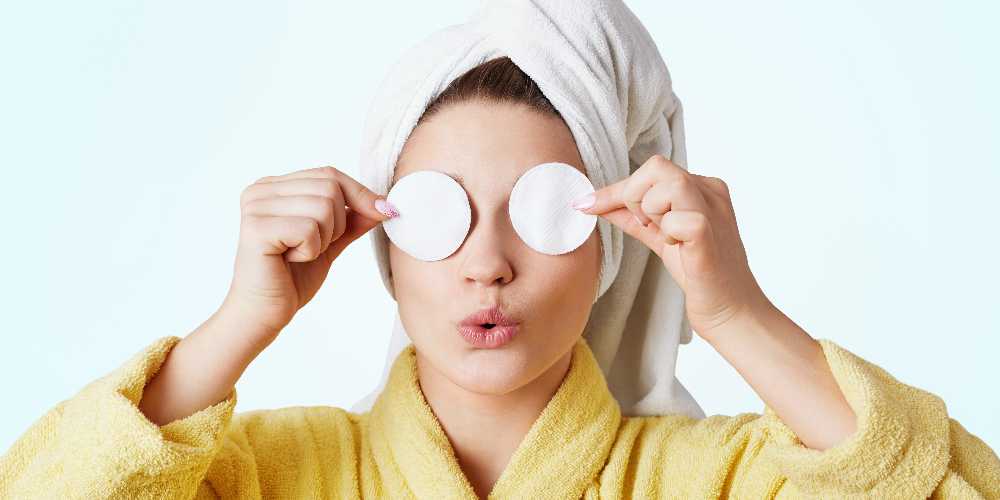
When you apply cold to this area, it triggers vasoconstriction, the narrowing of blood vessels-which helps to quickly decrease inflammation and puffiness.
This method not only soothes the skin but also provides immediate, visible results, making it a favorite for those seeking fast relief. The sensation of coolness can also be calming, reducing any discomfort associated with swelling or irritation.
You can use a cold towel or ice cubes for this purpose. The recommended interval by the National Eye Institute for cold compresses is up to 20 minutes at a time.
Caffeinated Tea Bags
Caffeinated tea bags, especially those made from green or black tea, are a popular natural solution for under-eye bag treatment.
The caffeine in tea is known for its ability to constrict blood vessels and reduce swelling, which is particularly beneficial for the thin, sensitive skin under the eyes.
In addition to caffeine, tea contains powerful antioxidants and anti-inflammatory compounds, such as polyphenols and flavonoids, which help protect the skin from environmental stressors and promote healing. Green tea, in particular, is celebrated for its soothing and rejuvenating properties.
When the tea bags are cooled and placed over the eyes, they combine the benefits of cold therapy with the skin-enhancing effects of tea, providing a double-action remedy for under-eye swelling and dark circles.
Steep two black or green tea bags in hot water, squeeze out the excess, and chill in the fridge. Place the cooled tea bags over closed eyes for 15–30 minutes.
Also Read: The Amazing Benefits of Green Tea for Skin Health
Adequate Sleep
Adequate, high-quality sleep is essential for overall health and is directly linked to the appearance of bags under the eyes.
During sleep, the body repairs itself, balances fluids, and reduces inflammation. Poor sleep or irregular sleep patterns can disrupt these processes, leading to fluid retention and increased swelling under the eyes. The position in which you sleep also matters; lying flat can cause fluids to pool under the eyes overnight.

Elevating your head with an extra pillow encourages proper drainage and prevents fluid accumulation, resulting in a less puffy appearance in the morning.
Consistently getting 7–9 hours of sleep each night and maintaining a regular sleep schedule supports skin health, reduces stress hormones that can break down collagen, and helps keep the under-eye area looking firm and refreshed.
Research indicates that sleep deprivation can increase visible swelling under the eyes by more than 10 mm on a standard visual analog scale. Prioritizing sleep and proper head elevation is a foundational step in any under-eye bags treatment plan.
Gentle Massage
Gentle under-eye massage is a simple yet powerful way to reduce puffiness and boost circulation.
A study published in the International Journal of Cosmetics revealed that the level of hemoglobin under the eyes tended to be higher than that on the cheeks, suggesting that the eye bags may result from impaired circulation.
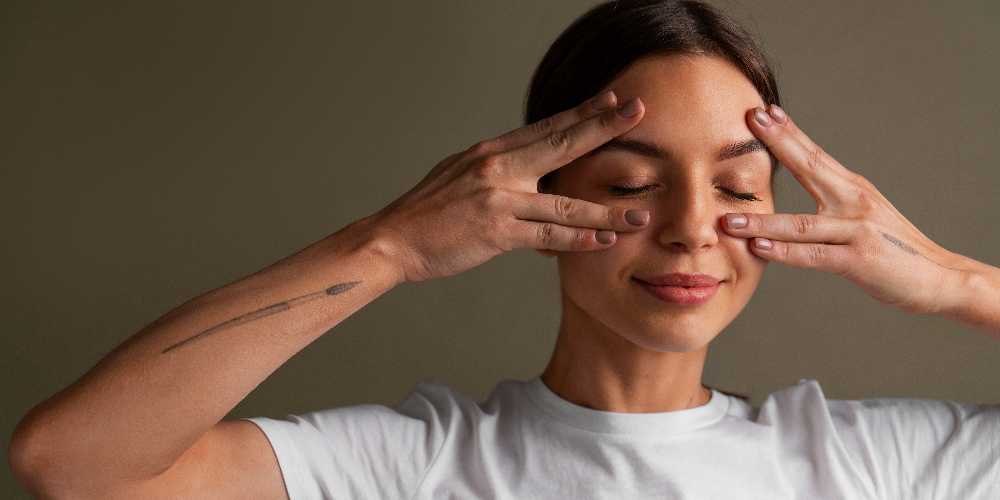
Using light pressure with your ring fingers, or a cool jade roller, you can stimulate blood flow and encourage lymphatic drainage, both of which help flush out excess fluid that causes under-eye bags.
This increased circulation brings more oxygen and nutrients to the skin, promoting healing and collagen production while minimizing dark circles and swelling.
For best results, gently tap or sweep from the inner corner of the eyes outward in slow, upward motions for about 30 seconds daily. Not only is this technique soothing, but it also energizes the under-eye area, leaving you looking more refreshed and revitalized.
Also Read: Facial Exercises for Skin Health: Everything You Need To Know
Increase Collagen Intake
Increasing collagen intake is a holistic home remedy that can help reduce bags under the eyes and swelling under the eyes by supporting the skin’s structure and elasticity.
Collagen, the most abundant protein in the body, naturally declines with age, leading to thinner, less resilient skin that is more prone to puffiness and sagging.

By incorporating collagen-rich foods such as bone broth, fish, chicken with skin, and egg whites into your diet, as well as foods that boost collagen production like citrus fruits, berries, leafy greens, nuts, and seeds, you provide your body with the building blocks needed to maintain healthy skin.
Over time, a diet that emphasizes collagen and its supporting nutrients can help strengthen the delicate under-eye area, making bags under eyes less noticeable and promoting a firmer, more youthful appearance.
Related Post: Top 5 Foods That Boost Collagen Production
Quit Smoking
Smoking accelerates the aging process of the skin, especially in the delicate under-eye area, by breaking down collagen and reducing blood flow. This leads to thinning of the skin, increased sagging, and more prominent bags under the eyes.
The toxins in cigarette smoke also contribute to inflammation and oxidative stress, which can worsen under-eye swelling and delay the skin’s natural healing processes.
Quitting smoking can halt this damage and allow the skin to begin repairing itself, resulting in a gradual reduction in puffiness and improvement in overall skin tone and texture.
Retinol-Based Under-Eye Cream
Retinol, a derivative of vitamin A, is a powerhouse ingredient in the fight against bags under the eyes.
Retinol works by promoting cell turnover and stimulating collagen production, which helps to thicken and firm the delicate skin under the eyes over time.
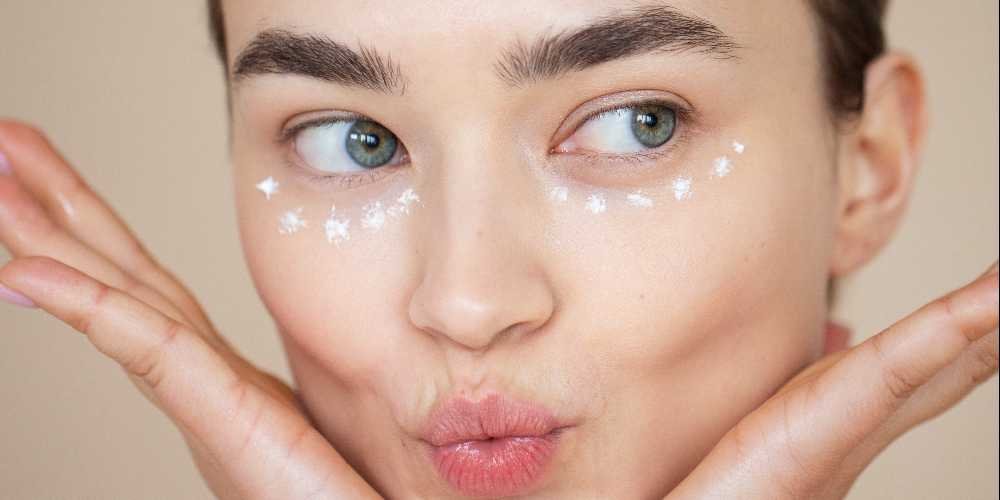
This increased collagen can reduce the appearance of fine lines, sagging, and even some of the hollowness that accentuates under-eye bags.
While retinol may not directly eliminate swelling, its long-term benefits include improved skin texture, elasticity, and resilience.
Also Read: 5 Best Skincare Ingredients of All Time
Medical Treatments
When the swelling is severe and home remedies and topical treatments aren’t enough, one should definitely look for medical treatments.
There are a number of available medical treatment options to treat under-eye bags. Some of them are mentioned below:
Lower Eyelid Surgery (Blepharoplasty)
Blepharoplasty is considered the gold standard for treating prominent bags under the eyes.
This outpatient surgical procedure involves the removal or repositioning of excess fat, tightening of muscles, and trimming of sagging skin beneath the eyes. The result is a smoother, firmer under-eye contour and a significantly rejuvenated appearance.
Surgeons typically make incisions along the natural creases of the eyelids or inside the lower lid, minimizing visible scarring.
Most patients experience long-lasting or even permanent results, with a low likelihood of needing future touch-ups. Blepharoplasty can also correct related issues such as droopy lower eyelids, excess upper eyelid skin, and vision interference caused by sagging skin.
Eudolift Therapy
Endolift therapy is an advanced, minimally invasive laser treatment that has gained popularity as an effective professional solution for bags under the eyes and swelling under the eye.
This innovative procedure uses a specialized micro-optical fiber inserted just beneath the skin, delivering targeted laser energy to stimulate collagen production, tighten loose tissues, and promote fat reduction in the treated area.
The heat generated by the laser causes immediate skin contraction and triggers a long-term remodeling process, resulting in firmer, smoother, and more youthful-looking under-eye skin.
A recent biometric study published in Lasers in Medical Science has demonstrated that Endolift laser treatment can significantly increase both the dermis and epidermis thickness as well as skin elasticity in the under-eye area.
Notably, the results indicated good to very good improvement in about 90% of patients who underwent this therapy.
Photographic data evaluation further supported these findings, showing a 90% improvement in the appearance of eye bags, suggesting that Endolift laser is a safe and highly effective method for lower eye bag treatment, offering noninvasive yet satisfactory results with minimal downtime and side effects.
Dermal Fillers
Dermal fillers, most commonly based on hyaluronic acid, are a minimally invasive option for those with hollowing or mild to moderate under-eye bags.
Fillers are strategically injected into the tear trough groove between the lower eyelid and the upper cheek to restore lost volume, smooth transitions, and camouflage puffiness. By filling in these hollows, fillers can reduce shadowing and make bags under the eyes less noticeable, creating a fresher, more rested look.
The procedure is quick, requires little to no downtime, and results are visible almost immediately. However, the effects are temporary, typically lasting 6–18 months.
Laser Resurfacing
Laser skin resurfacing uses targeted light energy to remove damaged skin layers and stimulate collagen and elastin production.
Fractional CO2 lasers are especially effective for the delicate under-eye area, helping to tighten loose skin, smooth wrinkles, reduce pigmentation, and improve overall skin texture.
Laser treatments can also lessen the appearance of under-eye swelling by tightening the skin and supporting structure. Results can be long-lasting, but several sessions may be needed.
Frequently Asked Questions
1. Can I permanently get rid of bags under my eyes?
Mild to moderate bags under the eyes can often be managed with lifestyle changes and topical treatments. Severe cases may require medical or surgical intervention for the best treatment for bags under the eyes.
2. What’s the fastest way to reduce under-eye puffiness?
Cold compresses and caffeine-based eye creams can provide quick relief for puffiness under the eyes.
3. Are under eye bag treatment options different for men?
No, the same science-backed treatments work for bags under the eyes in men and women, though men may need to address unique lifestyle factors.
4. Can under-eye bags go away naturally?
Mild under-eye bags can improve with simple lifestyle changes like better sleep, hydration, reduced salt intake, and cold compresses. However, if the puffiness is due to aging or genetics, more targeted treatments may be necessary.
5. How often should I massage the under-eye area to see results?
For best results, aim to massage the under-eye area once or twice a day, ideally in the morning to reduce overnight puffiness and at night to promote lymphatic drainage before sleep. Consistency over a few weeks can lead to noticeable improvements.
6. Can eye creams alone get rid of under-eye bags?
Eye creams can help reduce the appearance of under-eye bags, especially those containing ingredients like caffeine, peptides, retinol, or hyaluronic acid. However, for long-term or severe puffiness, creams work best in combination with lifestyle changes and massage.
Our Top Blog: How to Get Clear Skin? 20 Tips That Include Everything

